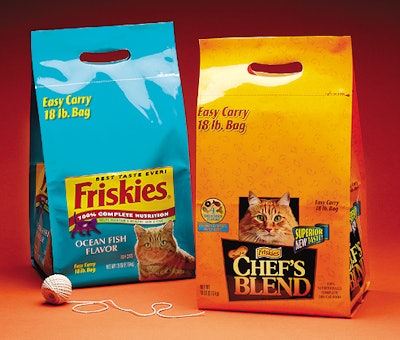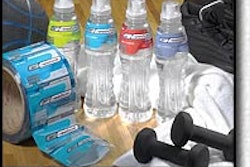
Packaging innovation is what consumers can expect to find when they walk down the pet-food aisle of their local grocery store in the near future. Convenience has a lot to do with it. It’s become so crucial a component in the whole pet-food marketing mix that those who manufacture and package pet food spend a lot of time innovating just to make sure their packages offer sufficient ease-of-use in the consumer’s hands.
“We’re really looking into things that are easy to display in the stores, things that are easy to use,” says Richard Thompson, vice president at The Meow Mix Co., Secaucus, NY. “Pet-food packaging hasn’t been easy to use. It’s been stuck in the 1960’s, if you will. We want to bring it into the 21st century.”
Another trend emerging in pet-food packaging is the notion that “bigger is better.” This makes ease of handling more important than ever. Says Anson Merrick of Nestlé Purina, “We’ve noticed a growth in the large-bag segment, as well as the convenience features of easy open, reclosability, easy carrying, etc. We’re really trying to be innovative.”
“Cat people are different than dog people,” Thompson says. “They tend to buy smaller bags, easy to open, easy close, keeps bugs out, and stuff that’s fun. We want to create something fun. So we’re certainly into being innovative. I’ve hired a full-time person who’s just looking into that.”
And while this innovation means a higher price tag for the manufacturer, and sometimes the consumer, pet-food producers are willing to take that risk.
“I’m a clear believer that with the right type of packaging, you can deliver value to the consumers. People will be able to pay a nickel or a dime for added value, for example,” Thompson says.
Following are three examples of how pet-food manufacturers are dealing with the changes and trends in packaging within their industry.
Big time packaging
Noticing a growing demand for pet foods in the large-bag segment (18 lb and up), marketers at Nestlé Purina searched for a bag that would not only be large but also easy for the cat-owner to handle. The company may have found what it needs in the FlexBox™ PET/PE four-walled bag from Nordenia (Jackson, MO). The four-side sealed bag has been market-tested for Nestlé’s 18-lb packs of both Friskies-brand Oceanfish and Friskies-brand Chef’s Blend kibble for kitties. Nestlé is considering it as a replacement for the multiwall paper bag currently in use. Nordenia forms the bag and sends it to Nestlé’s contract packager for filling.
“We wanted to test an innovative concept in the large-bag arena,” says Anson Merrick of Nestlé. “And we wanted to see how retailers would respond.”
Available only at Kroger and WalMart stores, the FlexBox was in test for approximately three months. Nestlé is now studying further use of the unusual packaging concept. While it represents a price increase for Nestlé, “The goal would be to increase distribution on the brands in order to offset that increase in cost,” Merrick says.
Merrick also says the package’s advantages make the upcharge a worthwhile investment. Its shape and its easy-carry handles are very consumer friendly, he says. “The cube shape also makes it more space-efficient on pallets and in the customer’s home,” he adds.
Filled off-site at a contract packager, the bags are equipped with a built-in handle. Featuring the characteristics of a box, the package also allows four sides for graphics and product information. Additionally, the bag’s stackability, due in part to diagonally welded seals at the bottom, allows it to remain stable on a full-, half-, or quarter-sized pallet. The package can also be equipped with a “Lift&Lock” reclosure tab to help keep food fresh.
While Friskies is continuing to test other packaging concepts, Merrick says the FlexBox “represented a step towards innovating the large pet-food bag.” He continues, “It is in line with our desire to be innovative with packaging and leaders in the industry.”
Eat-from pet-food container
Convenience is once again the main driver behind the design of a new pet-food container currently in use by Covi, a French food manufacturer. Supplied by Crown Cork & Seal (Philadelphia, PA), the single-serve steel container is topped with a heat-sealed, polypropylene peelable lid. The 110-g (3.8-oz) cat food is available in 12 varieties. The dog food, in a 300-g (10.6-oz) serving, comes in 14 flavors.
Chosen for its unique ability to maximize brand impact during Covi’s Top Chef brand’s entry into the competitive pet-food market, the container eliminates the need for can openers and requires little cleanup. All the consumer needs to do is peel off the lid, place the can on the floor as if it were the pet’s food dish, and throw it away when the food is gone. The can is said to be 100% recyclable.
The Covi container is coated with a clean, porcelain-looking white PP laminate on the outside for aesthetic purposes. A self-stick adhesive pad is located at the bottom of the container to stick it to the floor, helping to avoid mess.
Product information and graphics are currently gravure printed on a pressure-sensitive label applied to the top and bottom of the can.
Covi is planning on releasing its dog and cat food in the eat-from can to the United States some time next year, a spokesperson for Covi says.
Bundling up the savings
Pet-food manufacturers are also paying close attention to their secondary packaging operations. Doane Pet Care is a good example.
In an effort to save time, money, and space, this Butler, MO, firm turned to Packaging Machines Intl. (Elk Grove Village, IL) and its SIR55 automatic inline shrink wrapping system. According to Steve Allen, plant manager for Doane, a previous shrink bundling unit produced loose, sloppy-looking bundles of the company’s gabletop-style bags of pet-food.
It wasn’t just appearance that improved. “The new PMI bundler increased our output by about 33 percent,” Allen says. “It has saved us about 25 percent on labor as well. Not to mention that the old bundles would have been unacceptable to the new customer that we took on when we purchased the [PMI] bundler.”
Doane Pet Care manufactures and packs private-label products for store brands and national brands, as well as its own regional brands. Because there are so many different brands and sizes, changeover time is extremely important. The only changes necessary when going from size to size is a quick adjustment of the pusher plate that aligns packages going into the bundler, and input modifications made by the operator to the machine’s touchscreen controls.
Another major advantage for the pet-food manufacturer is the machine’s small footprint. According to PMI, the SIR55 is less than 50% the size of its major competitors. For Doane Pet Care, this means they have twice the amount of floor space available at 2/3 the price of the bigger machines.
“We are always looking for a vendor that can give us the best equipment, at a competitive cost, and we feel we’ve achieved that goal here,” Allen says.
Bags bundled on the PMI system can weigh as little as 5 lb or as much as 12 lb. They’re conveyed into the machine from a metal detector. Product is collated into various packaging patterns via a positive retracting backstop. A servo-driven main ram pushes the grouped packages through the film. At the side tack closure station, two heated bars descend to seal the ends of the package, creating a completely enclosed package.
The multipack is then conveyed through the shrink tunnel and discharged into the conditioning station. There, packages are pushed together one final time by vertical belts while the film, which is still warm, is being cooled by driers simultaneously. This helps create a tighter pack. The finished packages are discharged onto a conveyor to be palletized.
According to Allen, some trends he’s facing in pet-food packaging are variation in sizes of packages, as well as differing materials to coat the bags. As always, aesthetics are at the forefront of pet-food packaging innovation.
“Labor cost and appearance were extremely important in deciding to go with this new machine,” he says. “Beyond speed, these were the most important aspects of our decision.”






















